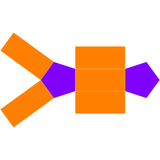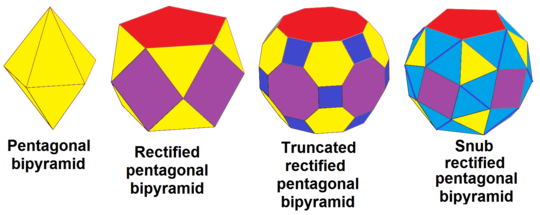Pentagonal bipyramid: Difference between revisions
Dedhert.Jr (talk | contribs) expand the article, sources later. The article is in under construction, and may possbly continue in few times later. |
Dedhert.Jr (talk | contribs) sources |
||
| Line 24: | Line 24: | ||
== Construction == |
== Construction == |
||
Like other bipyramids, the pentagonal bipyramid can be constructed by attaching the base of two pentagonal pyramids. These pyramids cover their pentagonal base, such that the resulting polyhedron has 10 triangles as its faces. The pentagonal bipyramid is said to be right if the pyramids are symmetrically regular and both of their apices are on the line passing through the base's center; otherwise, it is oblique. If the pyramids are regular, then all edges of the triangular bipyramid are equal in length, making up the faces [[equilateral triangle]]s. A polyhedron with only equilateral triangles as faces is called a [[deltahedron]]. There are only eight different convex deltahedra, one of which is the pentagonal bipyramid with regular faces. More generally, the convex polyhedron in which all faces are regular is the [[Johnson solid]], and every convex deltahedra is a Johnson solid. The pentagonal bipyramid with the regular faces is among numbered the Johnson solids as <math> J_{13} </math>, the thirteenth Johnson solid. |
Like other bipyramids, the pentagonal bipyramid can be constructed by attaching the base of two pentagonal pyramids. These pyramids cover their pentagonal base, such that the resulting polyhedron has 10 triangles as its faces.{{r|trigg}} The pentagonal bipyramid is said to be right if the pyramids are symmetrically regular and both of their apices are on the line passing through the base's center; otherwise, it is oblique. If the pyramids are regular, then all edges of the triangular bipyramid are equal in length, making up the faces [[equilateral triangle]]s. A polyhedron with only equilateral triangles as faces is called a [[deltahedron]]. There are only eight different convex deltahedra, one of which is the pentagonal bipyramid with regular faces. More generally, the convex polyhedron in which all faces are regular is the [[Johnson solid]], and every convex deltahedra is a Johnson solid. The pentagonal bipyramid with the regular faces is among numbered the Johnson solids as <math> J_{13} </math>, the thirteenth Johnson solid.{{r|uehara}} |
||
== Properties== |
== Properties== |
||
| Line 72: | Line 72: | ||
==References== |
==References== |
||
{{reflist |
{{reflist|refs= |
||
<ref name="trigg">{{cite journal |
|||
| last = Trigg | first = Charles W. |
|||
| year = 1978 |
|||
| title = An infinite class of deltahedra |
|||
| journal = Mathematics Magazine |
|||
| volume = 51 |
|||
| issue = 1 |
|||
| pages = 55–57 |
|||
| doi = 10.1080/0025570X.1978.11976675 |
|||
| jstor = 2689647 |
|||
| mr = 1572246 |
|||
}}</ref> |
|||
<ref name="uehara">{{cite book |
|||
| last = Uehara | first = Ryuhei |
|||
| year = 2020 |
|||
| title = Introduction to Computational Origami: The World of New Computational Geometry |
|||
| url = https://books.google.com/books?id=51juDwAAQBAJ |
|||
| publisher = Springer |
|||
| isbn = 978-981-15-4470-5 |
|||
| doi = 10.1007/978-981-15-4470-5 |
|||
| s2cid = 220150682 |
|||
}}</ref> |
|||
}} |
|||
==External links== |
==External links== |
||
Revision as of 06:21, 7 March 2024
This article or section is in a state of significant expansion or restructuring. You are welcome to assist in its construction by editing it as well. If this article or section has not been edited in several days, please remove this template. If you are the editor who added this template and you are actively editing, please be sure to replace this template with {{in use}} during the active editing session. Click on the link for template parameters to use.
This article was last edited by Dedhert.Jr (talk | contribs) 2 months ago. (Update timer) |
| Pentagonal bipyramid | |
|---|---|
 | |
| Type | Bipyramid, Johnson J12 – J13 – J14 |
| Faces | 10 triangles |
| Edges | 15 |
| Vertices | 7 |
| Vertex configuration | V4.4.5 |
| Schläfli symbol | { } + {5} |
| Coxeter diagram | |
| Symmetry group | D5h, [5,2], (*225), order 20 |
| Rotation group | D5, [5,2]+, (225), order 10 |
| Dual polyhedron | pentagonal prism |
| Properties | convex, face-transitive, (deltahedron) |
| Net | |
 | |

In geometry, the pentagonal bipyramid (or dipyramid) is third of the infinite set of face-transitive bipyramids, and the 13th Johnson solid (J13). Each bipyramid is the dual of a uniform prism.
Although it is face-transitive, it is not a Platonic solid because some vertices have four faces meeting and others have five faces.
Construction
Like other bipyramids, the pentagonal bipyramid can be constructed by attaching the base of two pentagonal pyramids. These pyramids cover their pentagonal base, such that the resulting polyhedron has 10 triangles as its faces.[1] The pentagonal bipyramid is said to be right if the pyramids are symmetrically regular and both of their apices are on the line passing through the base's center; otherwise, it is oblique. If the pyramids are regular, then all edges of the triangular bipyramid are equal in length, making up the faces equilateral triangles. A polyhedron with only equilateral triangles as faces is called a deltahedron. There are only eight different convex deltahedra, one of which is the pentagonal bipyramid with regular faces. More generally, the convex polyhedron in which all faces are regular is the Johnson solid, and every convex deltahedra is a Johnson solid. The pentagonal bipyramid with the regular faces is among numbered the Johnson solids as , the thirteenth Johnson solid.[2]
Properties
The pentagonal dipyramid is 4-connected, meaning that it takes the removal of four vertices to disconnect the remaining vertices. It is one of only four 4-connected simplicial well-covered polyhedra, meaning that all of the maximal independent sets of its vertices have the same size. The other three polyhedra with this property are the regular octahedron, the snub disphenoid, and an irregular polyhedron with 12 vertices and 20 triangular faces.[3]
Formulae
The following formulae for the height (), surface area () and volume () can be used if all faces are regular, with edge length :[4]

Related polyhedra
The pentagonal bipyramid, dt{2,5}, can be in sequence rectified, rdt{2,5}, truncated, trdt{2,5} and alternated (snubbed), srdt{2,5}:
The dual of the Johnson solid pentagonal bipyramid is the pentagonal prism, with 7 faces: 5 rectangular faces and 2 pentagons.
| Dual pentagonal bipyramid | Net of dual |
|---|---|

|

|
See also
| Bipyramid name |
Digonal bipyramid |
Triangular bipyramid |
Square bipyramid |
Pentagonal bipyramid |
Hexagonal bipyramid |
... | Apeirogonal bipyramid |
|---|---|---|---|---|---|---|---|
| Polyhedron image |

|

|

|

|
... | ||
| Spherical tiling image |

|

|

|

|

|
Plane tiling image |
|
| Face config. | V2.4.4 | V3.4.4 | V4.4.4 | V5.4.4 | V6.4.4 | ... | V∞.4.4 |
| Coxeter diagram |
... |
References
- ^ Trigg, Charles W. (1978). "An infinite class of deltahedra". Mathematics Magazine. 51 (1): 55–57. doi:10.1080/0025570X.1978.11976675. JSTOR 2689647. MR 1572246.
- ^ Uehara, Ryuhei (2020). Introduction to Computational Origami: The World of New Computational Geometry. Springer. doi:10.1007/978-981-15-4470-5. ISBN 978-981-15-4470-5. S2CID 220150682.
- ^ Finbow, Arthur S.; Hartnell, Bert L.; Nowakowski, Richard J.; Plummer, Michael D. (2010), "On well-covered triangulations. III", Discrete Applied Mathematics, 158 (8): 894–912, doi:10.1016/j.dam.2009.08.002, MR 2602814.
- ^ Sapiña, R. "Area and volume of the Johnson solid J₁₃". Problemas y ecuaciones (in Spanish). ISSN 2659-9899. Retrieved 2020-09-04.
External links
- Weisstein, Eric W., "Pentagonal dipyramid" ("Dipyramid") at MathWorld.
- Conway Notation for Polyhedra Try: dP5









